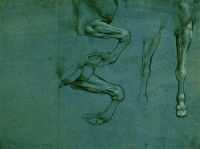The Natural World Click on the thumbnails to explore the trail
Read more about this trail (expand)
Leonardo’s endless curiosity regarding the form and function of all natural phenomena is attested to in his drawings, manuscripts and paintings. As nature could only be understood by direct “experience” or engagement with real life models, man, plants, animals, and the world that they inhabited became the subject of intense scrutiny in the quest for understanding of all natural things.

- Enlarge
- Zoom & explore
- © Biblioteca Reale, Torino
Four studies of horses' legs c1489-90
Leonardo’s drawings for the Equestrian Monument for Francesco Sforza mark the beginning of a period of intense study of equestrian anatomy from nature. In a series of nature studies executed in silverpoint on blue paper, Leonardo adopted a sculptural technique of drawing to translate the forms of the living animal into sculptural mass.
While in some drawings, Leonardo conceives of the entire horse, on this sheet, which is probably from a sketchbook, Leonardo focuses on individual parts – the raised forelock and straight, weight-bearing legs of the horse. The studies are arranged neatly on the page to form a careful record that would undoubtedly provide a useful guide for the modelling of the clay model for the bronze cast Sforza horse.
The bent, left foreleg seen on the bottom left of the sheet is the last of the four studies executed and this reflects the final solution adopted for the colossal statue. This element was repeatedly studied in other drawings by the artist, which indicates that he was particularly interested in the potential of this element to express the impending movement and power of the horse.
In Leoanrdo's words
…draughtsmanship is of such excellence that it not only investigates the works of nature but also infinitely more than those made by nature…On this account we should conclude that it is not only a science but a goddess.
While in some drawings, Leonardo conceives of the entire horse, on this sheet, which is probably from a sketchbook, he focuses on individual parts – the raised forelock and straight, weight-bearing legs of the horse.
The studies are arranged neatly on the page to form a careful record that would undoubtedly provide a useful guide for the clay model of the Sforza horse.
The bent, left foreleg on the bottom left is the last of the four studies executed and this reflects the final solution adopted for the colossal statue. This element was repeatedly studied in other drawings by the artist, which indicates that he was particularly interested in the potential of this element to express the impending movement and power of the horse.
- Medium Metalpoint, highlighted with brush and white gouache, on dark blue prepared paper
- Size 15.5 x 20.4 cm
- Location Biblioteca Reale










